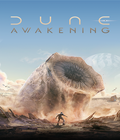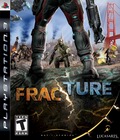Genre: Third-Person Shooter
Publisher: LucasArts
Developer: Day 1 Studios
Release Date: October 7, 2008
One issue that many people raise concerning the present state of the video game industry is the lack of original IPs. With publishers obsessed with creating sequel after sequel for existing franchises, how can any creativity truly ever flourish? LucasArts is a good example of a company this criticism could be aimed at by acting as the industry's Star Wars game factory, but they and Day 1 studious have put forth a very noble effort to bring something new to the table with Fracture. While it may not have a world-famous license behind it, Fracture's claim to fame comes from its unique terrain deformation system, whereby gamers can alter the landscape of the ground beneath them. It's a very cool concept that makes for some fun moments, but is sadly implemented in ways that only mildly alter the third-person shooter, rather than redefine it.
Fracture's story may be set in the year 2161, but is deeply rooted in present-day environmental concerns. Intense climatic changes have swept away the central region of the United States, physically and idealistically separating both coastlines. The Pacifican organization on the West Coast has chosen to experiment with genetic engineering in order to survive, while the Atlantic Alliance has focused on developing cybernetic technology instead. Due to a conflict in views, both factions have been brought into a civil war, and Alliance soldier Jet Brody is caught in the middle with the task of preventing Pacifican forces from destroying the East Coast. The setting for Brody's adventure is certainly interesting, but is ultimately ruined by a dull, barely existent plot stretching from San Francisco to Washington D.C., sporting shallow characters and a predictable giant walking machination of death.
But who needs a good story when there's great gameplay to be had, right? Day 1 sets up the player with a very comfortable control scheme and the usual assortment of weapons one would expect in any action game, such as assault rifles, rocket launchers and shotguns. A couple of more nifty ones include an underground torpedo and the sticky grenade-launching Black Widow, but of course, the real thing we're interested in is the terrain deformation. Brody's basic landscaping tool is the Entrencher, which can either raise the terrain (R1) or lower it (L1), and will eventually give the player the ability to boost himself high into the air. An assortment of earth-shattering grenades is also included (accessed through the d-pad and thrown with L2), and they can raise or lower the ground with an explosive accompaniment. Other explosives include Spike grenades, which raise large spires that can serve as lifting tools, and the very dangerous Vortex grenade, which concocts an impressive cyclone capable of decimating an entire area.
During combat, terrain deformation carries a variety of strategic applications, from creating cover on the fly to immediately dropping enemies into a crevice, effectively trapping them, but the deformation weaponry doesn't just come in handy during armed encounters. Manipulating the terrain may be done to reach different higher areas and uncover switches, or if a bridge needs to be raised, a spike grenade can be used to create a supporting column. At certain points, the terrain will have to be manipulated to move shield-busting spheres, but due to the imprecise nature of the terrain system, these sections can be a major pain.
Even though it is original, the overall use of the terrain mechanic can get to be a bit of a chore as the campaign wears on. When venturing indoors, there are still some areas that contain natural ground, which takes the player from one big sandbox to another and causes Fracture's main selling point to feel somewhat compartmentalized. The player receives shield and melee upgrades as he progresses through the campaign, but the terrain deformation stays exactly the same. Once you get past that, Fracture's nature as an incredibly average third-person shooter rises to the surface. The majority of enemies in the game make little use of the terrain technology to attack the player, and only about two different types of Pacifican soldiers are present for most of the journey. There are the high-jumping Hydras and "Tremors"-inspired Creepers, which burrow underneath the ground, but really, all the Pacificans amount to be are lab rats for some terrain experimentation, instead of being formidable interesting enemies.
There is a vehicle segment that makes use of the TDV1, which can raise the ground to create jumps and grind down steep hills, but the entire romp is also mired by linearity, taking place in a very constrictive, non-branching canyon. When the six- to seven-hour campaign is complete, a weapon testing area is unlocked, where objects and enemies can be summoned for some quick action, but there's little else to do within the small free-roaming space.
It's easy to imagine some awesome potential for Fracture's multiplayer component, but it pains me to say that even here, things are pretty flat. Up to 12 players can battle across maps inspired by the single-player campaign, set in desert bases and the ruins of Washington D.C., but only eight maps are provided. Sorry Day 1, but just because we can manipulate the terrain doesn't mean that the value of each map doubles.
Nevertheless, my play sessions yielded some truly hectic antics, as every combatant is armed with an Entrencher, so get ready to be thrown off your feet multiple times by hills springing up everywhere. The regular deathmatch and CTF game types are present, as well as Excavation, a mode exclusive to the Fracture. In it, two teams are tasked with raising spires at multiple locations on a map, and must attempt to take down the enemy's structures. In truth, this is just a regular control point contestation mode with a Fracture twist, and that's the multiplayer in a nutshell. The terrain deformation can make some fun skirmishes, but there are very few creative modes or maps to support it, thus keeping Fracture's multiplayer firmly grounded in familiar territory.
Fracture may not run on the Unreal 3 engine, but it sure looks like it. Yes, this means that all of the characters and environments contain a great amount of detail, but it also means that its art direction looks very similar to other games. Heck, Brody himself looks like he just got out of an Unreal Tournament III match. It's possible to draw even more direct comparisons to Epic titles, but in general, all of the game's environments, spanning industrial factories and a mine cart level, possess a very generic feel. This doesn't mean the game is without its pretty moments (see the degree of scale when confronting the hulking Dreadnaught), but there are a couple of quirks I noticed, such as a liberal use of motion blur and a liquefied appearance of changing terrain, that make it look like fluctuating 3D geometry rather than real terra firma. Fracture possesses quite the riveting orchestral score that does a good job as far as setting a mood goes, but there's little to get excited about in the voice acting department, which supplies performances about as one-dimensional as the character design.
Regardless of these setbacks, LucasArts and Day 1 do deserve kudos for taking such a risky endeavor by integrating the terrain deforming mechanic. I can't recall seeing anything like Fracture in a game before, and I have to admit that I had quite a good time launching enemies into the air by putting a mountain right under their feet. When it comes to the game as a whole, though, terrain is but a fraction of the entire experience, and here Fracture falls flat, with few other outstanding qualities to make it stand out from the rest. The enemies and level design are repetitive, the holes you make yourself contain more depth than the story line, and I can't believe Epic hasn't sued over the art direction. Despite the enjoyable landscaping element, Fracture still manages to feel like almost any other third-person shooter on the market; it might be fun to toy around with for a few hours in both single- and multiplayer, but don't expect the enjoyment to last for long.
Score: 7.5/10
More articles about Fracture











 In addition to extraordinary weaponry that allows players to do things previously only imagined, each side of the conflict, Pacifica and the Atlantic Alliance, boast soldiers with powers beyond those of ordinary men. Genetic augmentations provide Pacifican forces with amazing abilities, while Atlantic Alliance soldiers like Briggs counter the threat with the more "traditional" method: cybernetics. The differing states of superhumanity result in balanced yet stylistically different combat tactics that have never been seen before.
In addition to extraordinary weaponry that allows players to do things previously only imagined, each side of the conflict, Pacifica and the Atlantic Alliance, boast soldiers with powers beyond those of ordinary men. Genetic augmentations provide Pacifican forces with amazing abilities, while Atlantic Alliance soldiers like Briggs counter the threat with the more "traditional" method: cybernetics. The differing states of superhumanity result in balanced yet stylistically different combat tactics that have never been seen before.





























